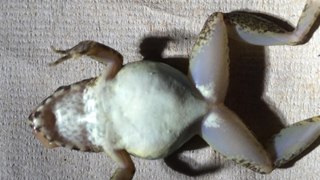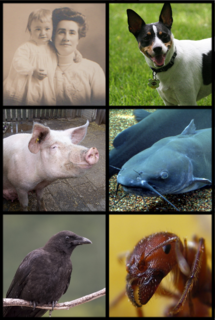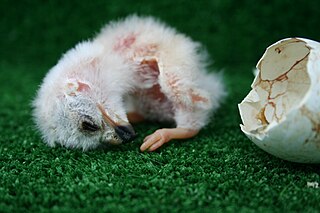
Matrotrophy is a form of maternal care during embryo development.

Matrotrophy is a form of maternal care during embryo development.
Some flowering plants supplied the developing embryos for the first stages. The ovule has no stocks and the nutrients are provided by the "mother".
In plants, matrotrophy is considered a critical evolutionary development preceding the origin of embryophytes and therefore essential to the evolution of land plants. [1] Matrotrophy is facilitated by cytological and ultrastructural modifications on one or both sides of the generational junction, a region called the placenta. [2] Specialization of the placental cells pertains further to their cytological and ultrastructural characteristics: the cytoplasm is often dense and rich in lipids, the vacuole is typically reduced but large in Sphagnum , the endoplasmic reticulum extensive, mitochondria numerous and large, chloroplasts numerous, often less differentiated, rich in lipid-filled globuli and sometimes filled with starch. [2]
It is associated with live birth (viviparity), in which the embryo of an animal is supplied with additional nutrition from the mother (e.g. through an organ such as placenta or other forms of nutrients providing, e.g. ovatrophy). This can be contrasted with strict lecithotrophy as in oviparity, in which the only source of nutrition for the embryo is the yolk originally contained within the egg.
While commonly associated with vertebrates and especially mammals, matrotrophy is found in 21 of 34 animal phyla, and is fairly common in 11 of those. [3] It has arisen independently in more than 150 clades within Chordata [4] and in more than 140 clades amongst invertebrates. [3]

A carnivore, meaning "meat eater", is an animal whose food and energy requirements derive solely from animal tissue or meat, whether through hunting or scavenging. Animals that depend solely on animal flesh for their nutrient requirements are called obligate carnivores while those that also consume non-animal food are called facultative carnivores. Omnivores also consume both animal and non-animal food, and, apart from the more general definition, there is no clearly defined ratio of plant to animal material that would distinguish a facultative carnivore from an omnivore. A carnivore at the top of the food chain, not preyed upon by other animals, is termed an apex predator.
Developmental biology is the study of the process by which animals and plants grow and develop. Developmental biology also encompasses the biology of regeneration, asexual reproduction, metamorphosis, and the growth and differentiation of stem cells in the adult organism.
Gestation is the period of development during the carrying of an embryo or fetus inside viviparous animals. It is typical for mammals, but also occurs for some non-mammals. Mammals during pregnancy can have one or more gestations at the same time, for example in a multiple birth.

Amniotes are a clade of tetrapod vertebrates comprising the reptiles, birds, and mammals. Amniotes lay their eggs on land or retain the fertilized egg within the mother, and are distinguished from the anamniotes, which typically lay their eggs in water. Older sources, particularly prior to the 20th century, may refer to amniotes as "higher vertebrates" and anamniotes as "lower vertebrates", based on the discredited idea of the evolutionary great chain of being.

Among animals, viviparity is development of the embryo inside the body of the parent, eventually leading to live birth. This is opposed to oviparity which is a reproductive mode in which females lay developing eggs that complete their development and hatch externally from the mother.

Ovoviviparity, ovovivipary, ovivipary, or aplacental viviparity is an outmoded term used as a "bridging" form of reproduction between egg-laying oviparous and live-bearing viviparous reproduction. Ovoviviparous animals have the embryos develop inside eggs that remain in the mother's body until they are ready to hatch.

Among animals which produce eggs, the yolk is the nutrient-bearing portion of the egg whose primary function is to supply food for the development of the embryo. Some types of egg contain no yolk, for example because they are laid in situations where the food supply is sufficient or because the embryo develops in the parent's body, which supplies the food, usually through a placenta. Reproductive systems in which the mother's body supplies the embryo directly are said to be matrotrophic; those in which the embryo is supplied by yolk are said to be lecithotrophic. In many species, such as all birds, and most reptiles and insects, the yolk takes the form of a special storage organ constructed in the reproductive tract of the mother. In many other animals, especially very small species such as some fish and invertebrates, the yolk material is not in a special organ, but inside the egg cell (ovum).

The egg is the organic vessel containing the zygote in which an embryo develops until it can survive on its own, at which point the animal hatches. An egg results from fertilization of an egg cell. Most arthropods, vertebrates, and mollusks lay eggs, although some, such as scorpions, do not.

A proboscis is an elongated appendage from the head of an animal, either a vertebrate or an invertebrate. In invertebrates, the term usually refers to tubular mouthparts used for feeding and sucking. In vertebrates, a proboscis is an elongated nose or snout.
A syncytium or symplasm is a multinucleate cell which can result from multiple cell fusions of uninuclear cells, in contrast to a coenocyte, which can result from multiple nuclear divisions without accompanying cytokinesis. The term may also refer to cells interconnected by specialized membranes with gap junctions, as seen in the heart muscle cells and certain smooth muscle cells, which are synchronized electrically in an action potential.

The endosperm is a tissue produced inside the seeds of most of the flowering plants following fertilization. It is triploid in most species. It surrounds the embryo and provides nutrition in the form of starch, though it can also contain oils and protein. This can make endosperm a source of nutrition in animal diet. For example, wheat endosperm is ground into flour for bread, while barley endosperm is the main source of sugars for beer production. Other examples of endosperm that forms the bulk of the edible portion are coconut "meat" and coconut "water", and corn. Some plants, such as orchids, lack endosperm in their seeds.

Myrmecophytes are plants that live in a mutualistic association with a colony of ants. There are over 100 different genera of myrmecophytes. These plants possess structural adaptations that provide ants with food and/or shelter. These specialized structures include domatia, food bodies, and extrafloral nectaries. In exchange for food and shelter, ants aid the myrmecophyte in pollination, seed dispersal, gathering of essential nutrients, and/or defense. Specifically, domatia adapted to ants may be called myrmecodomatia.
A trophic egg, in most species that produce them, usually is an unfertilised egg because its function is not reproduction but nutrition; in essence it serves as food for offspring hatched from viable eggs. The production of trophic eggs has been observed in a highly diverse range of species, including fish, amphibians, spiders and insects. The function is not limited to any particular level of parental care, but occurs in sub-social species of insects as well as a few other species like the frogs Leptodactylus fallax and Oophaga, and the catfish Bagrus meridionalis.

In biology, placentation refers to the formation, type and structure, or arrangement of the placenta. The function of placentation is to transfer nutrients, respiratory gases, and water from maternal tissue to a growing embryo, and in some instances to remove waste from the embryo. Placentation is best known in live-bearing mammals (theria), but also occurs in some fish, reptiles, amphibians, a diversity of invertebrates, and flowering plants. In vertebrates, placentas have evolved more than 100 times independently, with the majority of these instances occurring in squamate reptiles.

Cannibalism is the act of consuming another individual of the same species as food. Cannibalism is a common ecological interaction in the animal kingdom and has been recorded in more than 1,500 species. Human cannibalism is well documented, both in ancient and in recent times.

The southern grass skink is a species of lizard in the family Scincidae. The species is endemic to Australia, where it is found in the south-east of the continent, as well as in Tasmania and the islands of Bass Strait. Although it occurs in a variety of habitats, it is most commonly found in open grassy woodlands.

An omnivore is an animal that has the ability to eat and survive on both plant and animal matter. Obtaining energy and nutrients from plant and animal matter, omnivores digest carbohydrates, protein, fat, and fiber, and metabolize the nutrients and energy of the sources absorbed. Often, they have the ability to incorporate food sources such as algae, fungi, and bacteria into their diet.

Pregnancy has been traditionally defined as the period of time eggs are incubated in the body after egg-sperm union. Although the term often refers to placental mammals, it has also been used in the titles of many international, peer-reviewed, scientific articles on fish, e.g. Consistent with this definition, there are several modes of reproduction in fish, providing different amounts of parental care. In ovoviviparity, there is internal fertilization and the young are born live but there is no placental connection or significant trophic (feeding) interaction; the mother's body maintains gas exchange but the unborn young are nourished by egg yolk. There are two types of viviparity in fish. In histotrophic viviparity, the zygotes develop in the female's oviducts, but she provides no direct nutrition; the embryos survive by eating her eggs or their unborn siblings. In hemotrophic viviparity, the zygotes are retained within the female and are provided with nutrients by her, often through some form of placenta.

Animals make use of a variety of modes of reproduction to produce their young. Traditionally this variety was classified into three modes, oviparity, viviparity, and ovoviviparity.